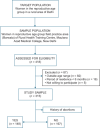A Cross-Sectional Epidemiological Study of Abortions in a Rural Area of Delhi
- PMID: 40124829
- PMCID: PMC11927870
- DOI: 10.4103/ijcm.ijcm_558_23
A Cross-Sectional Epidemiological Study of Abortions in a Rural Area of Delhi
Abstract
Background: Abortions in India are increasing despite the laws to legalize them. Many abortions are conducted through unsafe practices and are underreported. To determine the prevalence of abortions in women of a reproductive age group in a rural area of Delhi and to determine associated factors.
Methodology: A cross-sectional study was conducted among married women in the reproductive age group residing in Barwala village, Delhi/NCR. An interview schedule was used to interview 315 women, and information was obtained for socio-demography, use of contraceptives, medical history, and history of abortions. Chi-square and Fisher's exact test were used for analyzing the association of abortions with other variables.
Results: Of all 315 women, 47% had a history of one or more abortions. Of all pregnancies (n = 953), 25.6% ended in abortions (n = 244). Of the total number of abortions reported, 60.7% (n = 148) were induced, while 39.3% (n = 96) were spontaneous. Of induced abortions, only 35% were safe, while 65% were unsafe abortions. Age of mother, age at marriage, history of contraception use, and gender of first child were significantly associated with abortions. However, no significant association was found with socio-economic status, education, and occupation of women and their spouses. Only 1.3% women knew that abortions are legal in India.
Conclusion: A high proportion of women are going for induced abortions, of which a greater proportion is that of unsafe abortions. There is also lack of knowledge about the legalisation of abortions in India.
Keywords: Abortion; contraceptive use; safe abortions; unsafe abortions.
Copyright: © 2025 Indian Journal of Community Medicine.
Conflict of interest statement
There are no conflicts of interest.
Similar articles
-
Prevalence of induced abortions and contraceptive use among married women in an urban slum of Delhi, India.Int J Gynaecol Obstet. 2017 Jan;136(1):29-32. doi: 10.1002/ijgo.12011. Epub 2016 Nov 3. Int J Gynaecol Obstet. 2017. PMID: 28099705
-
Examining the rural-urban divide in predisposing, enabling, and need factors of unsafe abortion in India using Andersen's behavioral model.BMC Public Health. 2022 Aug 5;22(1):1497. doi: 10.1186/s12889-022-13912-4. BMC Public Health. 2022. PMID: 35932007 Free PMC article.
-
Unsupervised Medication-Induced Abortions: A Cross-Sectional Study in a Tertiary-Care Hospital.Cureus. 2025 Apr 26;17(4):e83049. doi: 10.7759/cureus.83049. eCollection 2025 Apr. Cureus. 2025. PMID: 40432632 Free PMC article.
-
Abortion and fertility regulation.Lancet. 1996 Jun 15;347(9016):1663-8. doi: 10.1016/s0140-6736(96)91491-9. Lancet. 1996. PMID: 8642962 Review.
-
Polycystic Ovary Syndrome prevalence and associated sociodemographic risk factors: a study among young adults in Delhi NCR, India.Reprod Health. 2025 Apr 28;22(1):61. doi: 10.1186/s12978-025-02019-9. Reprod Health. 2025. PMID: 40296029 Free PMC article.
References
-
- Abortions worldwide this year: Worldometer. Available from: https://www.worldometers.info/abortions/ . [Last accessed on 2022 Nov 18]
LinkOut - more resources
Full Text Sources

